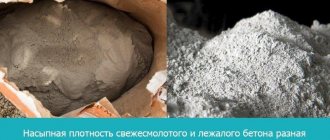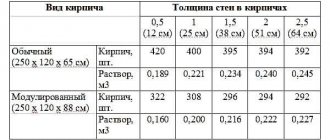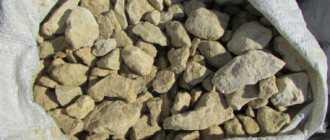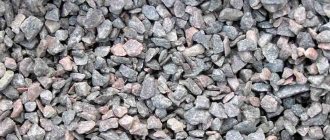How much sand and crushed stone do you need for a bag of cement?
In this case, the composition of the proportion will be as follows: one bag of cement 50 kg + 55 kg of sand + 125 kg of crushed stone. Proportions cement - sand - crushed stone for preparing concrete of various grades of cement M500.
Interesting materials:
How to register IMEI tele2? How to register a personal taxpayer account for an individual? How to register a child on mos ru? How to register for the Mamba dating site? How to register for Tao Bao? How to register at pharmacy ru? How to register for BlueStacks 4? How to register on Google Play Store? How to register in your Post Bank Personal Account? How to register for Skype for free?
Number of liters of cement in a 50 kg bag
How many cubes are in a bag of cement - calculation and volume tables
There is no need to buy extra cement. When stored for a long time, even in a dry room, it loses strength. In a year it will be 50% of the nominal value. That is why when purchasing it is worth knowing how much binder is required. But there may be problems here. Proportions for concrete mortar are often given in volume fractions, and cement is sold by weight, packaged in bags. Calculations may require the volume of cement in the bag. You can use the average and calculate approximately.
Cement bag volume
In general, the question of how much cement is contained in a bag is not so easy to answer. Let's start with the fact that packaging comes in bags of 25 kg, 40 kg and 50 kg. So we need to clarify the mass. The second point is that cement comes in different forms. With or without additives. And additives also come in different types, and different types differ in density. This means that the same weight occupies a different volume.
The weight of a bag of cement can be 25 kg, 40 kg and 50 kg
There is one more point. The density of any cement changes over time. Immediately after production, when it was poured into bags, the density is the lowest. As the ground powder is poured in, the particles become charged and capture air molecules. Therefore, freshly poured it weighs less. During transportation and storage, the charge decreases, some of the air evaporates, and the density increases. So after a month more weight is placed in the same volume. Moreover, after about a year of storage, the difference with the bulk density is significant - up to 35% of the original value.
In the calculations, an average figure is taken, which is called specific density. For each type of cement it is different and in calculations when determining the amount of material required, you can build on it.
Calculation method
The specific density of cement is the mass of one cubic meter. For Portland cement, for example, it is 1300 kg/m³. To determine the volume of cement in a 50 kg bag, you need to solve a simple proportion:
How to calculate the volume of cement in a bag
We found what percentage of one cubic meter is contained in one 50 kg bag of Portland cement. This is 3.85%. This means that this container contains 0.0385 m³ (we simply “take a percentage” of the cubic meter).
Pivot table
For a bag of 25 kilograms, you can not count, but divide the resulting figure by two. One 25 kg bag of Portland cement contains 0.019 m³. For a 40 kg bag, you will have to calculate everything again. The result is 0.031 m³. Similar calculations must be done for all brands of cement with different densities. We did this and compiled the data into a table.
Volume of cement in a bag: table for different containers and different brands of binder
The table contains average values. If you know exactly the weight of a cube of your material (it can be indicated on the bag or you can weigh it and calculate it), it is better to recalculate. The difference is unlikely to be big, but still. How to calculate? Take a liter container, put it on the scales and weigh it. Pour cement - do not shake, do not compact. Just pour and weigh, and then take away the container weight. You will find how much a kilogram of cement you purchased weighs. Then you multiply by 1000 (one thousand liters in one cube) and you get the exact (almost) density of your material. You can use it later in calculations.
How much concrete will be produced from a bag of cement?
Often proportions are indicated in volume fractions and therefore, when making calculations, it is useful to know how much concrete can be made from one bag of cement. But we need to talk about a specific brand and a specific concrete solution. The proportions are different and you need to decide on this first. The difference is significant - this can be seen from the following table.
How much concrete will be produced from 10 liters of cement?
For each binder and each brand, you will again have to count separately. For each concrete, the approximate consumption of cement for the production of one cube of mortar is known. Based on these data, you can calculate how much solution can be obtained from a kilogram of cement. Next, it is easy to find out the amount of concrete that can be obtained from a bag of cement.
Binder consumption by concrete grade
For example, a cube of M300 concrete requires 350 kilograms of M400 cement. That is, from one kilogram we get 1 m³ / 350 kg = 0.0028 m³. To find out how much M400 concrete you can get from a 50 kg bag, multiply by 50. We get 0.14 m³. As you can see, the calculations are simple.
To consolidate the information, let’s calculate for M200 mortar and the same M400 Portland cement. This type of concrete requires 250 kg. Then from a kilogram we get 1 cubic meter / 250 kg = 0.004 cubic meters. Then from 50 kg it will be: 0.004 * 50 = 0.2 cubic meters, from 40 kg - 0.004 * 40 = 0.16 cubic meters.
[res1]
How many bags of cement in a cube
Concrete and cement-based mortar are widely used in construction. The costs of purchasing it are significant, so it is important to correctly determine the required quantity when purchasing. The consumption of cement, mortar and concrete is calculated in cubic meters. And since in most cases cement is sold in bags weighing 50 kg, it is extremely important to know the volume of the bag in cubes.
Determining the volume of cement in a bag
Mass depends on density. To find out how many cubes of cement are in a bag, you need to determine its density, which depends on the following factors:
- from the chemical composition,
- from the date of manufacture, since the newly manufactured one is lighter,
- on the characteristics of production, more precisely, on the size of the resulting individual particles,
- on the storage method.
Therefore, to answer the question: how many cubes is a 50 kg bag of cement, you need to divide the weight of the bag by its actual density value. For a simplified calculation, in practice the average density value is used, which is taken equal to 1300 kg/m3. Then the volume of cement in a 50 kg bag is determined by dividing 50 by 1300. The answer is 0.038 m3.
How many bags of cement are there in a cube of concrete?
When preparing to carry out construction work and trying to spend money as economically as possible, many developers find out before purchasing: how many bags of cement per 1 cubic meter of concrete do they need? To answer this question accurately, you will need to determine the actual density of the cement that has yet to be purchased. Therefore, first we calculate: how many bags of cement per 1 m3, for which we use the average value of the volume of cement per bag for grade M400, equal to 1: 0.038 = 26.3. Having specified how many bags of cement are in 1 cubic meter, you can easily calculate: how many bags of cement are needed per cubic meter of concrete, knowing the amount of cement in kilograms and the brand of concrete. However, it is easier to use regulatory data for this. For example, to make a cube of M300 concrete from M400 cement, 350 kg of cement is needed. packaged in 7 bags.
How many bags of cement per 1 cubic meter of mortar?
Knowing the brand of cement and the parameters of the solution, and also taking into account that the solution contains one part cement and three parts sand, you can find the answer from the table. However, for a more accurate answer, it is better to clarify the following solution parameters:
With the data obtained, the answer can be easily found in Table 4 in SP 82-101 of 1998. For example, to create 1 cubic meter of M300 mortar you need 510 kg of M500 cement, that is, slightly more than 10 bags.
How many liters of cement are in a 50 kg bag?
Often in everyday conditions the amount of cement is determined not in cubes, but in liters, and therefore the question is very relevant: how many liters are in a bag of cement? In order to simplify the calculation, let us take as a basis that one cube of cement, that is, 1000 liters, contains 1300 kg of cement. It turns out that cement in a 50 kg bag occupies a volume equal to 50: 1.3 = 38.5 liters.
Bulk density of cement
To determine how many kg of cement are in a 10 or 12 liter bucket, you must first find out the bulk density of the material. Usually the parameter is indicated in the quality certificate or in the instructions on the bag itself. Knowing the bulk density, it is not difficult to perform calculations. Factors affecting the bulk density of cement:
- The shelf life of the powder - the material only from the factory shows a value of 1100 kg/m3. During the grinding process, the particles of the material receive a static charge of the same sign, and therefore repel one another. The voids are immediately filled with air. But during transportation and storage, the static charge disappears, the cement becomes denser and the indicator can even increase to 1600 kg/m3.
- Features of production technology - this factor determines the size of air voids, the size of powder fractions, etc.
- The composition of the material is limestone, slag, microsilica, etc. They reduce the cost of cement, but also the density (and strength at the same time). Only Portland cement does not contain mineral additives, and in this case the bulk density is equal to an average of 1300 kilograms per cubic meter.
To obtain the desired indicator, it is enough to multiply the bulk density by the volume of the vessel. 1300 kilograms per cubic meter is 1300 grams per cubic centimeter.
1300 grams x 10 (liters) = 13000 grams = 13 kilograms holds one 10-liter bucket of Portland cement with a density of 1300 kg/m3. Knowing the density, you can not only determine how much cement is in a 10-liter bucket, but also calculate the mass of dry powder in any container. So, for a 12-liter bucket the calculations look like this: 1300 x 12 = 15600 = 15.6 kg.
Cement activity. Terms and conditions of storage
When purchasing Portland cement, be sure to pay attention to the date of its manufacture. Correct dosage calculation will not matter if the cement has been stored for a long time. During storage, cement “pulls” atmospheric moisture and gradually loses activity. At high humidity, after two to three weeks of storage after opening the bag, you can find a solid block or individual large pieces of compacted cement inside. Such material cannot be restored; it can be thrown away.
The manufacturer indicates the shelf life of cement in 50 kg bags is 6 months (M 600 - 3 months), but in reality cement is stored for no more than two months. In the first month, he may lose up to 50% of his activity. Thus, to obtain the mixture you need a brand, you should buy cement immediately before starting work and pay attention to the date of manufacture. Cement should be stored in a dry room at a positive temperature. Open the bags immediately before kneading.
Average bulk density of components and materials for concrete
Despite the simplicity of performing calculations using the method indicated above, it is not always possible to use it. The thing is that the bulk density of the material can change and is not always known exactly.
Calculation of the proportions of components for mixing concrete mortar is usually carried out in 12-liter buckets. And for sale, cement is packaged in packages weighing 50 kilograms (less commonly, a bag of cement weighs 20, 25 or 40 kg). If you decide to mix concrete yourself or prepare a solution for construction or finishing work, then to calculate the proportions ask yourself: how many buckets are in a 50 kg bag of cement and how many buckets of cement will you need at this stage of construction? Calculation technologies will make it possible to produce the required number of kilograms of cement mixture, so that it does not turn out to be less than necessary, and so that no excess is formed.
How to properly mix the solution in a concrete mixer. Mixing concrete mortar in a concrete mixer
Concrete is actively in demand not only in industrial construction, but also in private households. A small amount of solution can be easily mixed by hand. But if large volumes are required, it is better to use a concrete mixer.
- Rules for preparing concrete in a concrete mixer with your own hands
The densest materials are loaded first, and water is added at the end. Mixing is continued until the concrete becomes homogeneous and evenly colored.
Step by step diagram:
1. Installation of a concrete mixer.
To ensure high-quality mixing, you need to find a level place for the unit. An inclined position leads to uneven mixing with the formation of lumps. Frequent work on uneven surfaces quickly damages the blades of the mechanism.
It is not always possible to find a perfectly smooth surface on a work site. In this case, wooden blocks, fragments of bricks and other hard materials are placed under the mixer. The correct installation is checked using a building level.
2. Preparing the concrete mixer.
To prevent the mixture from sticking to the blades and walls during preparation, they are lubricated with machine oil, grease or liquid cement composition.
Before mixing the solution, you need to read the instructions and check the nominal capacity of the drum. Overloads negatively affect the quality of concrete, and the mixer quickly breaks down. The filling scheme looks like this: cement, sand, crushed stone (gravel), water. It is convenient to measure ingredients using a regular 10 liter galvanized bucket.
4. Kneading.
Preparing the solution in a concrete mixer takes no more than 2-5 minutes (depending on the type of axle). Long rotation leads to evaporation of moisture and reduced plasticity.
5. Checking readiness.
After mixing is complete, the drum needs to be tilted and some concrete unloaded. Its surface must be absolutely smooth. Then use a shovel or hoe to make several deep stripes. If they do not smooth out, then the solution is ready for use.
6. Unloading.
Upon completion of production, the concrete is completely drained. If the drum is large, then it is convenient to first unload the entire mixture into a large container (trough, container), and then gradually put it into a wheelbarrow or onto a stretcher. In this case, heavy particles do not settle at the bottom, but are evenly distributed throughout the entire mass. As a result, the solution becomes denser.
7. Cleaning the unit.
After preparation, fill the empty mixer with water and thoroughly rinse the blades, drum and drain hole.
Concrete composition
Main ingredients of the mixture:
- binder - cement;
- solid aggregates – sand and crushed stone (gravel, expanded clay);
- the connecting base is water.
During the manufacturing process of the solution, various additives are introduced into the composition:
- Slaked lime – promotes convenient installation of the mortar.
- Plasticizers – add viscosity or fluidity.
- Reinforcing components – enhance strength.
- Excipients are special additives that improve quality characteristics. For example, setting and hardening at low temperatures or high humidity.
Additives enrich and unify the composition, so their types and proportions are chosen based on the main purpose of the concrete.
The ratio of components in concrete
Strength, mobility and many other parameters are directly dependent on the proportions of materials. When carrying out small volumes of construction work, it is easier to measure the ingredients of the composition in buckets. To mix concrete yourself from cement, sand, crushed stone and water, it is enough to maintain the proportions of 2: 4: 8: 1. The result is a construction mixture of medium strength, its grade depends on the quality of the cement. For example, when using M350 in a ratio of 2:4:8:1, M200 comes out.
| Brand and class | Ratio, kg | Concrete yield from a cement bucket, l | ||
| cement | sand | crushed stone | ||
| M100 V7.5 | 1 | 4,6 | 7 | 78 |
| M150 V12.5 | 1 | 3,5 | 5,7 | 64 |
| M200 B15 | 1 | 2,8 | 4,8 | 54 |
| M250 B20 | 1 | 2,1 | 3,9 | 43 |
| M300 V22.5 | 1 | 1,9 | 3,7 | 41 |
| M350 B25 | 1 | 1,6 | 2,7 | |
| M400 B30 | 1 | 1,2 | ||
| M450 B35 | 1 |
How many kg of sand are in a 12 liter bucket?
The weight of dry construction sand (this figure is taken as a guide in construction work) is 18.4 kg in a 12-liter bucket. If this is river sand (again, dry), then its weight is 18.3 kg. If the sand is wet (river), then the bucket can contain 20 kg or even more.
Interesting materials:
How to use Yandex points in Yandex Market? How to use Yandex Money in Kazakhstan? How to use IS and Are? How to use calgon tablets to clean your washing machine? How to use Dragon Torso Stone? How to use the F keys on Mac? How to use codes in Sims 4 on PS4? How to use the chat wheel in Dota 2 plus? How to use convection in a microwave? How to use cream marshmallows?











